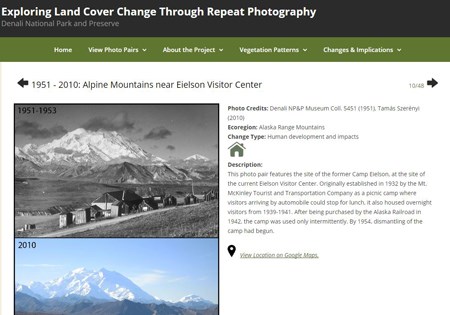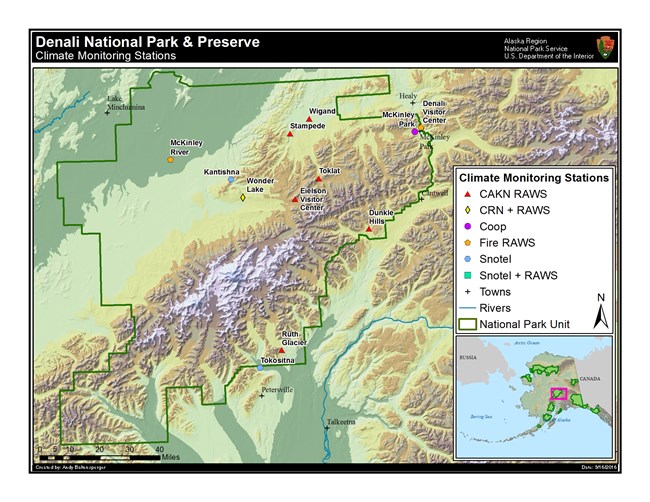

Left image
Right image
Change is ever-present in natural settings, and the landscape of Denali is no exception. Over the course of a day, flowers open and close as light plays on mountain flanks. Across the seasons, lakes and rivers freeze and thaw. And over thousands of years, glacial advances literally carve the landscape we see before us. Although many changes are natural and can be expected, Denali's landscape may also be imperiled by changes - those brought on by human activities. Human impacts can be seen most clearly in direct alterations of the landscape caused by infrastructure development, but there are also less obvious impacts resulting from our modification of the earth's climate system. 
Exploring Land Cover Change Through Repeat PhotographyGet a birds-eye view on Denali's changing landscape. Our partner's website contains a wealth of information about Denali's landscapes and allows you to view hundreds of matched historic/current photographic images that help us document and understand ecological changes occurring in the park. Explore the repeat photography collection About the Project The Denali Repeat Photography project has assembled more than 200 photo pairs taken across a large cross-section of Denali from the low-lying black spruce forests to ice fields high in the Alaska Range. What unites these disparate images is that they show repeated views of a single location at different moments in time. The interval separating the pairs of photos varies greatly - from just a few years to longer than a century! Some of the images reflect major changes that have occurred in the physical landscape such as shrinking of huge glaciers or changes in the size of lakes or ponds. Other photo pairs show changing patterns of vegetation such as the establishment of spruce trees in formerly treeless areas or shrubs invading wetlands, and some show changes humans have made by building structures and roads. Still other photos show no apparent change at all over long spans of time. The website serves as a clearinghouse of visual information about the wonderful and dynamic Denali landscape. The photographs have come from many different people and sources - from historical collections, longtime Denali researchers, and students visiting the area for the first time. 
Climate Monitoring in DenaliClimate is one of the important vital signs used to monitor long-term change across the park landscape. There are several climate/snow monitoring stations that provide information on temperature and precipitation patterns in Denali. Data are used to support natural resource programs including wildlife, vegetation, hydrology, and fire. Data are also used on a day-to-day basis for practical management issues such as visitor access, construction projects, road work, and aviation safety. 
Further Studies and Stories of a Changing Climate in Denali |
Last updated: March 30, 2020
